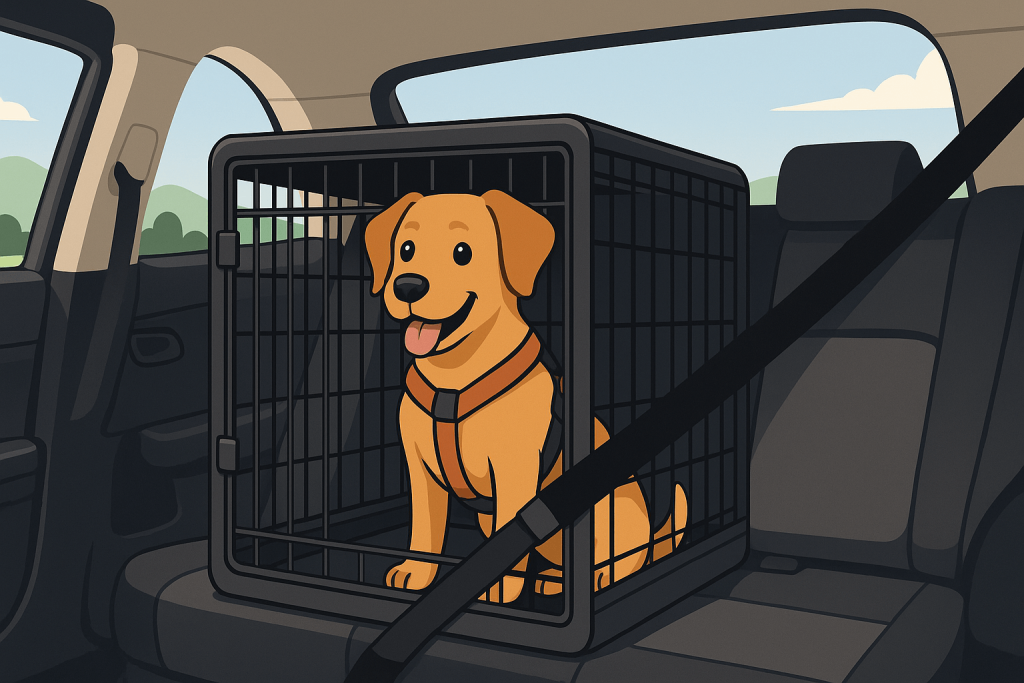Transporting your dog safely is one of the most important responsibilities you have as a pet owner. Whether it’s a quick trip to the vet or a cross-country adventure, keeping your dog secure during the ride should never be an afterthought. One of the most effective methods to ensure safety is to use a dog crate in your vehicle.
However, simply placing a crate in the backseat or cargo area isn’t enough. Understanding the right way to select, install, and use a crate will make all the difference in protecting your furry companion. Let’s explore how to do it properly.

Why Crate Travel Is the Safest Option
Dogs allowed to roam freely in a moving vehicle are at significant risk. In a crash or even a sudden stop, an unsecured dog can become a projectile, causing injury to themselves and others. Additionally, a frightened or excited dog can distract the driver, increasing the chances of an accident.
Using a crate not only protects your dog but also creates a safer driving environment for everyone in the vehicle. It’s a simple step that reduces risk dramatically and provides your dog with a secure, calming space during travel.
Choosing the Right Crate for Vehicle Use
Not all crates are suited for travel. When selecting a crate for car use, focus on the following factors:
- Crash-Tested Designs: Look for crates specifically tested for vehicle crashes.
- Durability: Materials like reinforced aluminum or heavy-duty plastic are ideal.
- Proper Ventilation: Ensure there is enough airflow to keep your dog comfortable.
- Escape-Proof Features: Strong latches and escape-proof construction are essential for safety.
Manufacturers such as Impact Dog Crates are known for offering high-quality, crash-tested options that are trusted by professionals and pet owners alike.
Positioning the Crate in Your Vehicle
Once you have the right crate, placement is critical:
- Use the Cargo Area: If you drive an SUV or wagon, position the crate in the cargo area, directly behind the back seats. This space typically offers better stability and protection.
- Secure with Tie-Downs: Use strong straps to secure the crate to anchor points in the vehicle. This prevents shifting during sudden stops or accidents.
- Avoid Front Seats: Placing a crate in the front passenger seat is dangerous due to airbag deployment risks.
Ensuring that the crate is stable and does not slide around is as important as the crate itself.
Preparing Your Dog for Crate Travel
Before heading out on a long trip, it’s essential to acclimate your dog to traveling in the crate:
- Practice at Home: Allow your dog to get comfortable sitting in the crate at home first.
- Short Trips First: Begin with short drives to positive destinations (like the park) to build positive associations.
- Make It Comfortable: Add a familiar blanket or a favorite toy to make the crate feel cozy.
- Avoid Feeding Right Before Travel: A full stomach can lead to motion sickness.
Taking the time to gradually introduce your dog to crate travel will reduce anxiety and help ensure a smoother journey.
Safety Tips During Travel
While the crate provides a strong foundation for safe travel, following these extra safety tips will further protect your dog:
- Regular Breaks: Stop every couple of hours to allow your dog to stretch, relieve themselves, and have some water.
- Never Leave Your Dog Unattended: In warm weather, the inside of a vehicle can become dangerously hot very quickly.
- Monitor Your Dog: Keep an eye on your dog’s behavior during travel. Excessive panting, whining, or signs of distress may require attention.
Following these practices not only enhances safety but also ensures that your dog enjoys the journey.
Benefits Beyond Safety
Using a crate in your vehicle isn’t just about minimizing injury risks. It also provides:
- Comfort and Security: Dogs feel more secure in a confined, stable space rather than being loose in a moving vehicle.
- Organization: Having a designated area for your dog helps keep the car tidy and free from pet hair and dirt.
- Ease of Travel: Whether it’s a quick run to the vet or a road trip vacation, travel becomes less stressful for both you and your dog when crate routines are established.
Trustworthy Resources for More Guidance
Finding trustworthy advice about traveling with dogs can be overwhelming, but reliable informational sites like dogsafetysystems.com make it easier. They offer detailed guides and expert tips without trying to sell products, helping dog owners make informed decisions based purely on safety and wellbeing.
If you’re looking to learn more about choosing the right crate, how to secure it properly, and travel best practices, dogsafetysystems.com is an excellent resource to explore.
